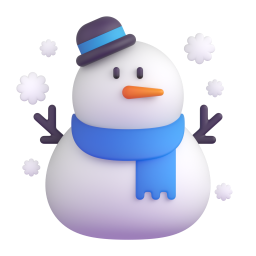☃️ Snowman
A classic snowman, as Frosty the Snowman, with snowflakes falling on it. Depicted as a snowman, facing forward, made from two or three large snowballs and stick arms, dressed with a top hat, a carrot nose, coal eyes, and two or three buttons on its torso. Sometimes shown with a smile and a red scarf. Often used for various content concerning winter fun and Christmastime. Vendors implement the same figure for their ⛄ Snowman Without Snow, which does not have snowflakes. Google’s snowman previously wore green gloves, while Samsung's design previously lacked a hat. This snowman predates Unicode emoji support, which explains why it may display as the black-and-white outline of a snowman.
☃️ Snowman
Also known as: Snowing Snowman
Image Variants

3D
Color
Flat
High Contrast
Version Information
Keywords
Shortcodes
| Platform | Shortcode | Action |
|---|---|---|
| Emojipedia | :snowman: | |
| GitHub | :snowman_with_snow: | |
| Discord | :snowman2: |
Additional Information
A snowman, shown under falling snow. This is an old text glyph, that includes an emoji presentation in iOS 9.1. Are you looking for the more http://emojipedia.org/snowman/
- Having a low or inadequate temperature or feeling a sensation of coldness or having been made cold by e.g. ice or refrigeration
- Having a low temperature.
- Turned into ice; affected by freezing or by long and severe cold
- A figure of a person made of packed snow
- A snowman is an anthropomorphic snow sculpture.
- A manlike figure formed out of snow.
- A temporary sculpture made of snow
- A figure sculpted from snow
- Winter is the coldest season of the year in polar climates and temperate climates, between autumn and spring.
- The coldest season of the year; in the northern hemisphere it extends from the winter solstice to the vernal equinox
- The coldest season of the year in temperate climates
- The season of winter, between autumn and spring
- Winter is one of the four seasons of temperate zones.
- Fourth season, marked by short days and lowest temperatures.
- Traditionally the fourth of the four seasons, typically regarded as being from December 23 to March 20 in continental regions of the Northern Hemisphere or the months of June, July and August in the Southern Hemisphere. It is the time when the sun is lowest in the sky, resulting in short days, and the time of year with the lowest atmospheric temperatures for the region.

